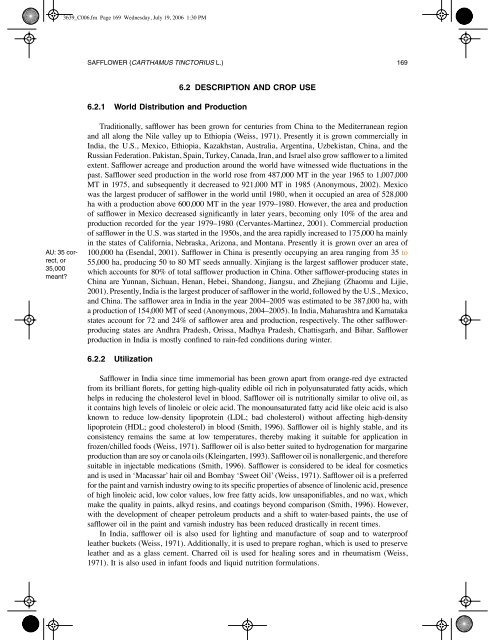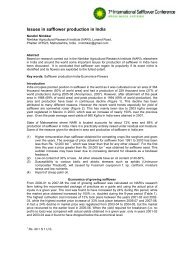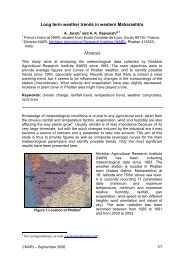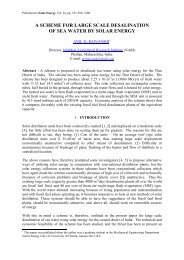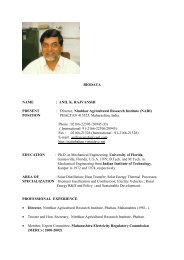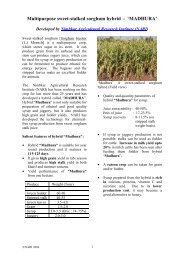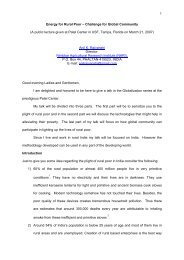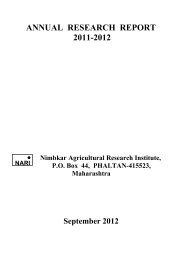Safflower (Carthamus tinctorius L.) - NARI
Safflower (Carthamus tinctorius L.) - NARI
Safflower (Carthamus tinctorius L.) - NARI
Create successful ePaper yourself
Turn your PDF publications into a flip-book with our unique Google optimized e-Paper software.
3639_C006.fm Page 169 Wednesday, July 19, 2006 1:30 PMSAFFLOWER (CARTHAMUS TINCTORIUS L.) 1696.2.1 World Distribution and Production6.2 DESCRIPTION AND CROP USEAU: 35 correct,or35,000meant?Traditionally, safflower has been grown for centuries from China to the Mediterranean regionand all along the Nile valley up to Ethiopia (Weiss, 1971). Presently it is grown commercially inIndia, the U.S., Mexico, Ethiopia, Kazakhstan, Australia, Argentina, Uzbekistan, China, and theRussian Federation. Pakistan, Spain, Turkey, Canada, Iran, and Israel also grow safflower to a limitedextent. <strong>Safflower</strong> acreage and production around the world have witnessed wide fluctuations in thepast. <strong>Safflower</strong> seed production in the world rose from 487,000 MT in the year 1965 to 1,007,000MT in 1975, and subsequently it decreased to 921,000 MT in 1985 (Anonymous, 2002). Mexicowas the largest producer of safflower in the world until 1980, when it occupied an area of 528,000ha with a production above 600,000 MT in the year 1979–1980. However, the area and productionof safflower in Mexico decreased significantly in later years, becoming only 10% of the area andproduction recorded for the year 1979–1980 (Cervantes-Martinez, 2001). Commercial productionof safflower in the U.S. was started in the 1950s, and the area rapidly increased to 175,000 ha mainlyin the states of California, Nebraska, Arizona, and Montana. Presently it is grown over an area of100,000 ha (Esendal, 2001). <strong>Safflower</strong> in China is presently occupying an area ranging from 35 to55,000 ha, producing 50 to 80 MT seeds annually. Xinjiang is the largest safflower producer state,which accounts for 80% of total safflower production in China. Other safflower-producing states inChina are Yunnan, Sichuan, Henan, Hebei, Shandong, Jiangsu, and Zhejiang (Zhaomu and Lijie,2001). Presently, India is the largest producer of safflower in the world, followed by the U.S., Mexico,and China. The safflower area in India in the year 2004–2005 was estimated to be 387,000 ha, witha production of 154,000 MT of seed (Anonymous, 2004–2005). In India, Maharashtra and Karnatakastates account for 72 and 24% of safflower area and production, respectively. The other safflowerproducingstates are Andhra Pradesh, Orissa, Madhya Pradesh, Chattisgarh, and Bihar. <strong>Safflower</strong>production in India is mostly confined to rain-fed conditions during winter.6.2.2 Utilization<strong>Safflower</strong> in India since time immemorial has been grown apart from orange-red dye extractedfrom its brilliant florets, for getting high-quality edible oil rich in polyunsaturated fatty acids, whichhelps in reducing the cholesterol level in blood. <strong>Safflower</strong> oil is nutritionally similar to olive oil, asit contains high levels of linoleic or oleic acid. The monounsaturated fatty acid like oleic acid is alsoknown to reduce low-density lipoprotein (LDL; bad cholesterol) without affecting high-densitylipoprotein (HDL; good cholesterol) in blood (Smith, 1996). <strong>Safflower</strong> oil is highly stable, and itsconsistency remains the same at low temperatures, thereby making it suitable for application infrozen/chilled foods (Weiss, 1971). <strong>Safflower</strong> oil is also better suited to hydrogenation for margarineproduction than are soy or canola oils (Kleingarten, 1993). <strong>Safflower</strong> oil is nonallergenic, and thereforesuitable in injectable medications (Smith, 1996). <strong>Safflower</strong> is considered to be ideal for cosmeticsand is used in ‘Macassar’ hair oil and Bombay ‘Sweet Oil’ (Weiss, 1971). <strong>Safflower</strong> oil is a preferredfor the paint and varnish industry owing to its specific properties of absence of linolenic acid, presenceof high linoleic acid, low color values, low free fatty acids, low unsaponifiables, and no wax, whichmake the quality in paints, alkyd resins, and coatings beyond comparison (Smith, 1996). However,with the development of cheaper petroleum products and a shift to water-based paints, the use ofsafflower oil in the paint and varnish industry has been reduced drastically in recent times.In India, safflower oil is also used for lighting and manufacture of soap and to waterproofleather buckets (Weiss, 1971). Additionally, it is used to prepare roghan, which is used to preserveleather and as a glass cement. Charred oil is used for healing sores and in rheumatism (Weiss,1971). It is also used in infant foods and liquid nutrition formulations.


